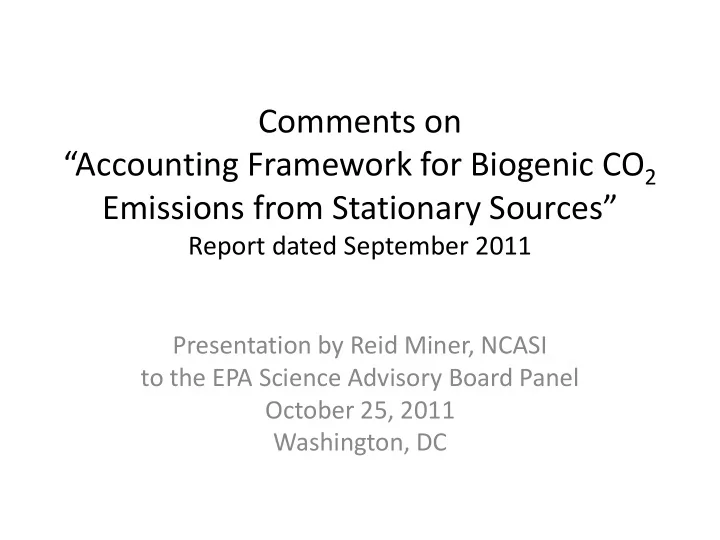

Comments on “Accounting Framework for Biogenic CO 2 Emissions from Stationary Sources” Report dated September 2011 Presentation by Reid Miner, NCASI to the EPA Science Advisory Board Panel October 25, 2011 Washington, DC
Two items to highlight • The framework should clarify that “anyway emissions” from manufacturing residues include those from; – kraft black liquor solids – other manufacturing residues from pulp, paper and wood products manufacturing • The intended application demands that the framework be more than theoretically sound. It must be workable.
Kraft black liquor solids • In going from wood to paper, much of the material in the wood must be removed, especially the lignin • A chemical pulping process, called the “kraft” process is by far the most common method for removing the lignin • The combination of residual materials removed from the wood (mostly lignin) and spent pulping chemicals is called black liquor solids • Black liquor solids are burned in a very carefully controlled reduction/oxidation process to (a) regenerate the pulping chemicals and (b) produce energy used throughout the mill
The material removed from wood to make paper or wood products ends up in manufacturing residues (anyway emissions) or by-products Black Turpentine liquor and soap solids by-products Numbers are tons 0.45 0.02 of biomass carbon Kraft Pulp Wood Chipping Pulping 1 Bark cleaning Paper 0.35 into and and removal and making mill screening chemical bleaching recovery 0.13 other manufacturing residues Bark and wood waste 0.05 (Based largely on Côté, 2002)
Case study 3 • We have submitted a revised case study relying on the same basic facts but treating kraft black liquor solid and other materials removed from the wood as manufacturing residues
It is critical to keep in mind that… This is not simply a modeling exercise. You are developing mandatory and legally enforceable emissions limits that involve the activities of thousands of stationary sources and thousands of land owners, so please consider…
Several critical questions Does the framework rely on accurate data available at reasonable • cost? Do the calculations rely on assumptions that create opportunities • for inconsistencies and introduce a large amount of uncertainty? Can the framework be applied consistently across the many • different combinations of forestry and manufacturing circumstances? What are the potential unintended consequences? • – carbon and economic leakage due to shifting of harvesting activities – carbon and economic leakage due to cross-border migration of forest products manufacturing operations – diminished value of forested land, increasing the incentive to convert forested land to non-forest uses (another form of leakage) – shift from biomass to fossil fuels because fossil fuels provide more useable energy per unit of carbon in the fuel (yet more leakage)
Please constantly ask yourselves, • “Is this complexity necessary?” • “Is this workable as an approach for developing legally enforceable emissions limits affecting thousands of stationary sources and land owners?” • What are the unintended consequences?
thank you please see our written comments
Recommend
More recommend